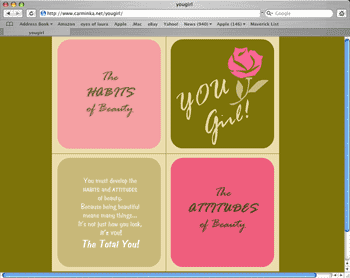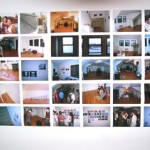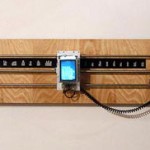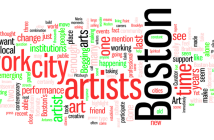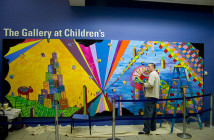Perhaps an appropriate show as Axiom’s finale at its Allston space, MASS MEDIA included the work of 21 new media artists in its comparatively small space. Axiom’s director and curator of MASS MEDIA, Heidi Kayser, assembled the show in an attempt to emulate the ubiquity of mass media. The show makes no grand statements and has no strong theme to bind it together; it is essentially a reflection. Though the title may imply a show about mass media (e.g. television, radio, internet), few of its works actually confront it. Of the works that do, few directly face modern mass media, a favorite subject of New Media artists, who make up the majority of the show.
Though the exhibition’s grounds are not of mass information dissemination and its culture consequences, there are works that take on that issue that hold the show together. Kayser was quick to point out the subversive online work of Carmin Karasic when we discussed the importance of mass media related works in MASS MEDIA. Her webart piece You Girl! very wittily uses the attributes of the web to deliver a sharp satire of prescribed behaviors for women. Based on the Wendy Ward Charm School book, the interface for the site is reminiscent of fashion magazines’ personality tests with a 1950’s aesthetic. It includes directions for certain situations women may encounter and even a voice analyzer to help you work on your charm. Karasik interspliced pictures and sounds of modern culture to point out the products of a society bound to the repressive strictures of such institutions like finishing schools, but takes the issue further with commentary on whiteness.
Eric Freeman’s foley work, or re-folied work is an old documentary film of men at work in a radio studio, perhaps creating the sound for an old radio serial. He provided his own sound for the film, replacing the sounds the foley artists were creating for the radio show with his own. Watching the foley artists run around a studio waving short rods in the air and banging various inanimate objects together to create a diagesis for the radio program was absurd and oddly humorous. Freeman’s ‘re-foleying’ of the footage points out the contrivance of mass media, and is indeed hilarious but at times disturbing.
Estevan Carlos’ work is more about New Media than most other works in the show. He experimented with degradation of image quality through the reproduction of several images through different mediums. It is in fact a commentary on the loss of information a concept or artwork might undergo when passing through the different types of media they must pass through to reach a wider and wider audience. Jane Marsching and Deb Todd Wheeler tackle a similar issue in Instructions for Seeing where two 5x7” LCD screens show footage of various instruments used for observation undergoing experimentation. Intercut within the documentary footage is dubious coverage of unexplainable events. The work reminds us how much mass media disables us from understanding our world.
Along with Marsching and Todd Wheeler’s work video was a popular medium for the show. Michael Sheridan’s single shot videos document spaces with the added sound editing and video speed alteration to intensify any events he wants to draw our attention to in the frame.
Alejandro Roberts’ Mind Salad, was a disappointment in the show. It’s highly modified video images were compelling but one might also refer to the work as Video Salad. More elemental was Denise Marika’s Gnaw, a close up shot of a deadpan face partially buried underground munching away in what looks to be an attempt to free itself. The work is morbidly disconcerting but the suspense created by such a scene forces the viewer to gaze at the face, contemplating its fate. Placing Marika’s work in a show meant to inspire notions of media omnipresence undermines the viscerility and personal nature of her work. Though this is one of the best works in the show.
Andrew Neumann and Liz Nofziger’s conspicuous use of technology in their works—the apparent circuitry and mechanical apparatus—bring the mechanics and the video images of their work together into one concept. Neumann’s work is much more self-conscious: a tiny video camera slowly scans over the grain of the wood board the piece is mounted on while an LCD screen sitting over the camera shows us the images. His work refigures the technology to enable a reading of his piece outside that of typical video and technologically based works. Nofziger’s piece requires the act of looking in order to complete her concept. An LCD screen, disassembled to its elemental parts, screens low grade footage of hundreds of ants attacking the dead or dying body of an unidentifiable chick. In order to discern what the footage actually is, the viewer nearly needs to get on their knees. I found myself feeling similar to a Cub Scout having their first experience with the cruelty of nature. The grittiness of the video removes the natural repulsiveness such a scene might inspire, but at the same time draws the viewer even closer to satisfy their desire to recognize the subject matter of the video.
An interesting curatorial decision was Michael Everett’s sculpture which was comprised of straws, push-pins and what looked like speaker wire. There are few works in the show about mass media, just works that use the equipment that mass media requires to operate and in this case, the artist took a basic approach to this idea. This piece may be the archetypal work for a show that is made up of works that all require some sort of electronic technology in order to function. The work describes to us, in essential form, what the curators think of as the media of MEDIA.
As Axiom’s mission is to support new mediums of art, it is an apt space for such an exhibition, but this is a risky idea for a show. There is a continuous deluge of media, of the mass media sort, all around us, and its effects seem endless and are widely unknown. However, one could also take this show’s logic and apply it to anything as pervasive as mass media, like asphalt for instance. MASS MEDIA indeed comes across as a survey of New Media artists. The work is disparate and in some cases a few years old, which is uncommon in New Media shows. The selections appear to be random as they come from such a large breadth of work, and the show’s authors admit that they are not keen on all the work.
In the end the show was disappointing because the resources for such a show, (the population of New Media artists from New York to Boston) were not exploited to their fullest extent. Even a show such as iKatun’s Info@Blah, which was criticized because of its apparent over-concentration on emerging technologies, had the merits of thorough curation and the more focused theme of information. MASS MEDIA’s merit seems to be its variety, but the better works were lost in its business. Though the variety provided for some unexpected pleasures in the end it helped to weigh down the show.
- James Manning’s documentation of the exhibition, in which he added images of the opening throughout the course of the opening.
- Andrew Neumann’s HAL (Verticle Conversation), 2001
- Carmin Karasic’s You Girl!
Links:
Axiom, Inc.
Carmin Karasic
Estevan Carlos
Liz Nofziger
"MASS APPEAL" was on view from Aug 19th-28th at Axiom, INC. in Allston, MA.
All images are courtesy of the artist and Axiom, Inc.

